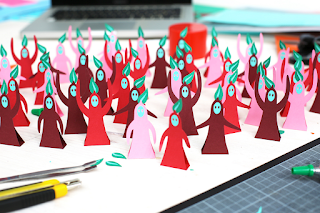 Lucie Thomas and Thibault Zimmerman are French artists who operate out of Dordogne, France. Zim & Zou (As they are collectively known) have backgrounds in graphic design who shifted their focus towards handcraft. The absence of computers in their work is what I find so fascinating. We live in a digital era where all of the math and tedious labour can be done for us. Instead of technological reliance, Zim & Zou logically construct, draw up and cut out their designs with their own hands. When looking at their work, they not only had to design how each piece would fold or cut, they also factored in which segments needed to be cut out of which colour of paper. Their work is not only a structural marvel, but a colour theorists dream.
Lucie Thomas and Thibault Zimmerman are French artists who operate out of Dordogne, France. Zim & Zou (As they are collectively known) have backgrounds in graphic design who shifted their focus towards handcraft. The absence of computers in their work is what I find so fascinating. We live in a digital era where all of the math and tedious labour can be done for us. Instead of technological reliance, Zim & Zou logically construct, draw up and cut out their designs with their own hands. When looking at their work, they not only had to design how each piece would fold or cut, they also factored in which segments needed to be cut out of which colour of paper. Their work is not only a structural marvel, but a colour theorists dream. What ties their work together for me, is the addition of a narrative. For myself, a real work of art comes to life when it tells a story. When looking at the paper worlds of Zim & Zou, I can't help but wonder the origin of this mushroom village or the nature of their buildings built atop pillars. Even though these worlds do not exist beyond the paper, I can't shake the feeling that these structures contain a history within themselves.
Where Zim & Zou inspire me the most is the attention to detail. You must have a lot of patience with this form of expression. You must also be incredibly nitpicky to ensure all of the pieces fit together as well as they do. As an artist, it can be very easy to learn which corners you can cut, metaophorically speaking. Literally speaking, Papercraft involves cutting corners over and over again. This is an important stage of the creation and tedious tasks are the easiest one to take shortcuts. Often times, this can result in a less than ideal end product. Zim & Zou have shown me the result of what meticulous detail, perseverance and patience can result in.













Comments
Post a Comment